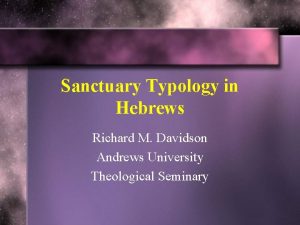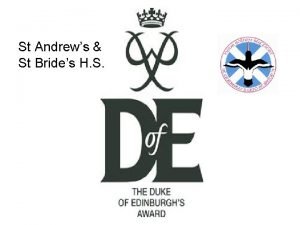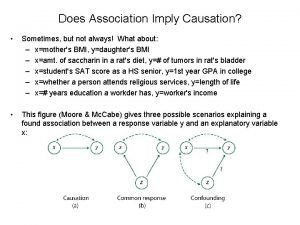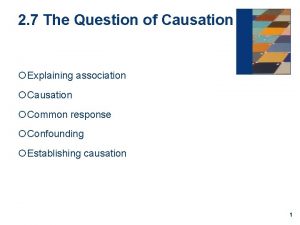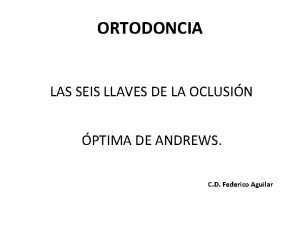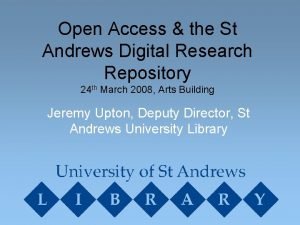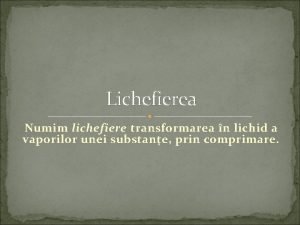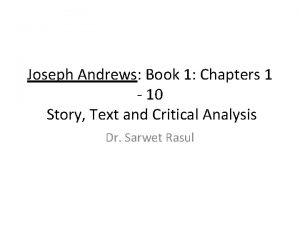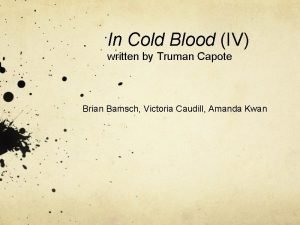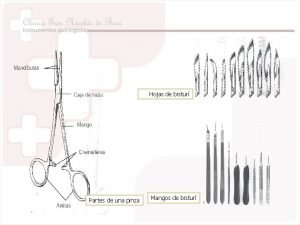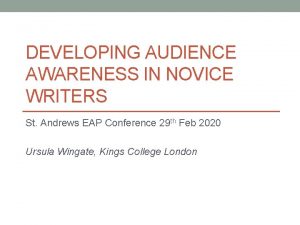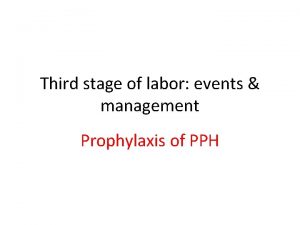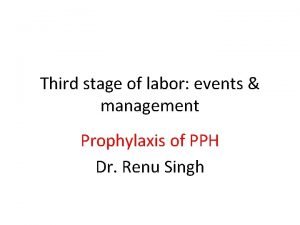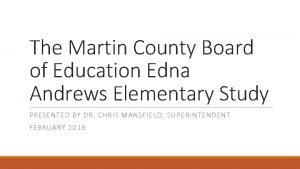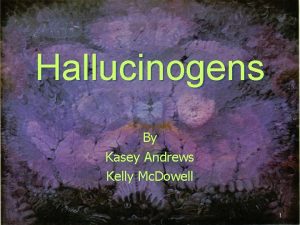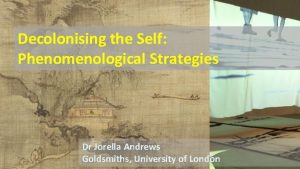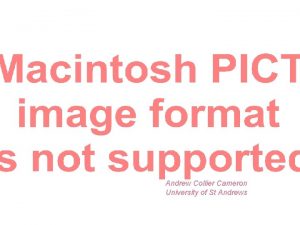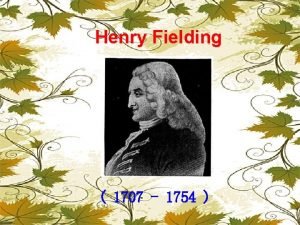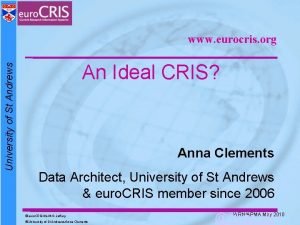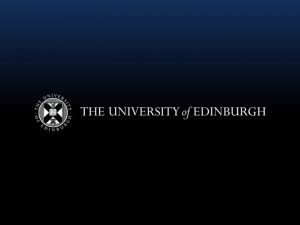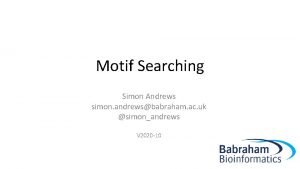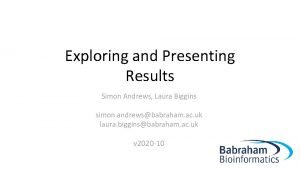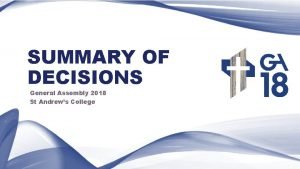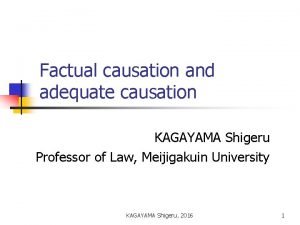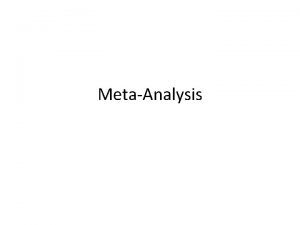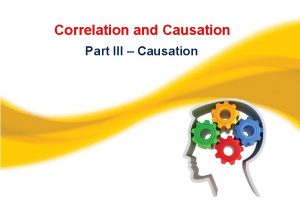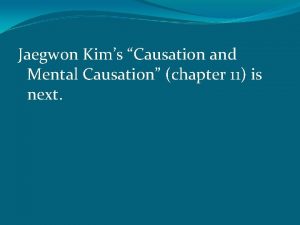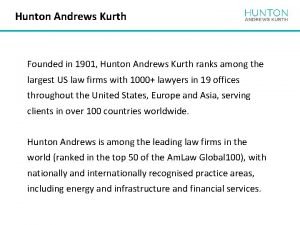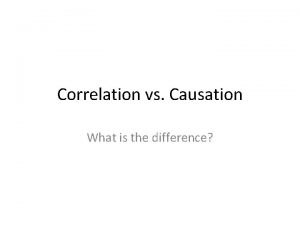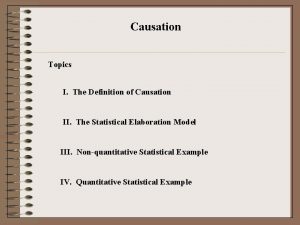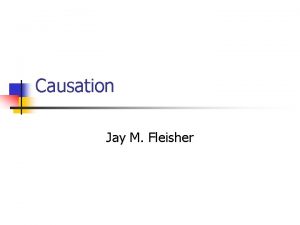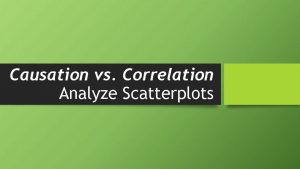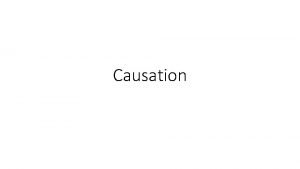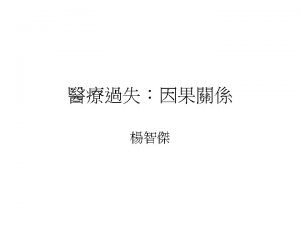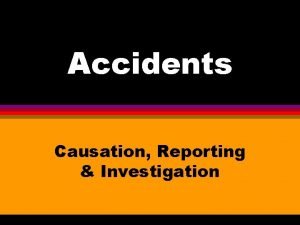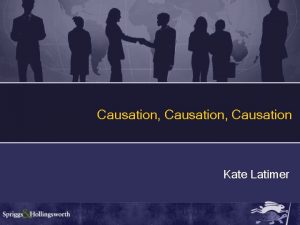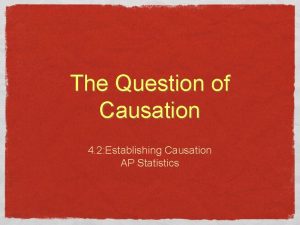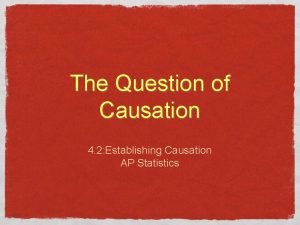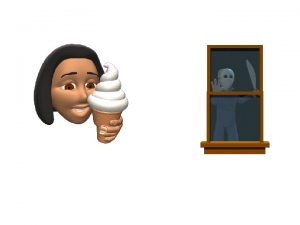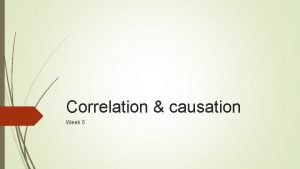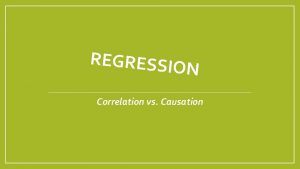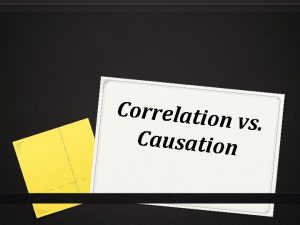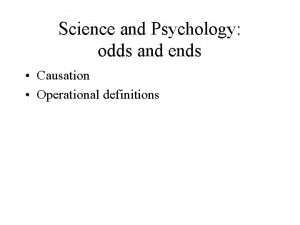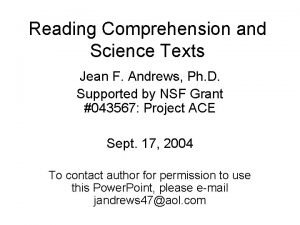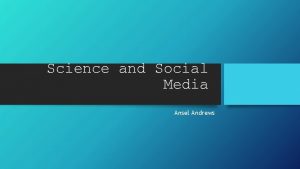Causation University of St Andrews Causation science and









































- Slides: 41

Causation University of St Andrews

Causation, science and common sense l We have a somewhat problem free handle on talk about causes, effects and causal explanations. l Example: l In science, acknowledging causes and effects is a central The beer got me so drunk that I fell down the stairs causing a fracture in my leg That explains why I am moving around using these crotches

Are there causes and effects? l We would normally not question that there are causes and effects. l There is an apparent necessity in causal relationships. l Hume’s account of causation is a reductive account. l Causation reduces to spatiotemporal contiguity, succession and constant conjunction. l Hume: Causes and effect are connected solely through regularity. l Regularities are just things or processes that we see repeated in nature. l We have no epistemic justification for saying that they are necessary –

The regularity view of causation RVC l c causes e iff (a) c is spatiotemporally contiguous to e (b) e succeeds c in time, and (c) all events of type C (i. e. , events that are like c) are regularly followed by or constantly conjoined with events of type E (i. e. events like e) (This formulation can be found on p. 19 Psillos, 2002) l Our ‘received view’ of causation tells us that causation happens in virtue of ‘something else’ l If c causes e, it is because there is some real connection between c and e (that necessitates e happening when c happens) l It is this view that is denies by Hume.

Mind Dependence of Causation l Power and Necessity is something that exists in the mind, not in objects” they “are consequently qualities of perceptions, not of objects, and are internally felt by the soul, and not perceiv’d externally in bodies” (Hume, Treatise, p. 166) l T’is a common observation that the mind has a great propensity to spread itself on external objects, and to conjoin with them any internal impression, which they occasion, and which always make their appearance at the same time as these objects discover themselves to the sense” (Hume Treatise p. 167) l Hume is an anti-realist regarding causation

Summing up RVC and a quick critique l The regularity view of causation tells us that all we mean by c causes e is that: c is spatiotemporally contiguous to e & e succeeds c in time, & all events of type C are regularly followed by (or constantly conjoined with events of type E. l Constant conjunction is not sufficient: A man imprisoned all his life has been exposed to the ringing of two clocks everyday. One is high and goes off before the other that is deep. (example due to Ducasse)

Good and Bad Regularities l there is a difference between kinds of regularities l Events that are not connected but appear together are not causally connected. l How do we point out those regularities that entail causal relationships from those that do not? Constant conjunction is not necessary for causation l l the striking of some rare gem with a hammer it would still count as an instance of causation. So: Constant conjunction is neither necessary nor sufficient for causation

The counterfactual approach to Causation l Hume also mentions the following definition of causation: "We may define a cause to be an object followed by another, and where all the objects, similar to the first, are followed by objects similar to the second. Or, in other words, where, if the first object had not been, the second never had existed. " (Hume, An Enquiry Concerning Human Understanding, 1748, Section VII). l Despite Hume noticing, this definition is very different from a regularity account Analysis of causation in terms of counterfactuals: Event c was a cause of event e if and only if c occurred and e occurred and if c had not occurred, then e would not have occurred.

What are ‘causes’ and ‘effects’ l The standard view of singular causation : a relation between two events. Example: When the cue ball knocks the eight ball into the pocket, there is the actual event e 1 of the cue ball striking the nine ball, and an actual (separate) event e 2 of the eight ball going into the pocket, such that e 1 is the cause and e 2 is the effect. e 1 causes e 2

How do we define the relata l There are two main suggestions for what category the relata belong to: 1) The relata can be Immanent (in space time) 2) The relata can be transcendent (not in space time) l There are two suggestions for how the relata are individuated: A) Coarse grained: The event of saying hello and saying hello loudly are the same event B) Fine grained: saying hello loudly is a separate event from saying hello

Immanent vs. Transcendent Objection to the transcendent conception l l l Only immanent relata can do the pushing and the pulling Replies: A’) The cue ball and the eight ball serve as concrete facta. B’) The objection rests on a pre-Humean conception of causation

How are the relata individuated Immanent: Coarse Grained Quine, Davidson Transcendent No one Fine Grained Kim, Lewis, Armstrong Dretske Mellor, Bennett Kim: Causal relata are triple [a, P, t], which are immanent – the fine graining depend on the fine graining of the properties Lewis: events are classes of possible spatiotemporal regions Bennet: Either Rusellian (as fine grained as Kim says, but abstract) or Fregean facts (more fine grained than Rusellian facts). See: Stanford Encyclopedia – metaphysics of Causation by Schaffer

First counterfactual definition & Events Analysis of causation in terms of counterfactuals: Event c was a cause of event e if and only if c occurred and e occurred and if c had not occurred, then e would not have occurred. This analyses of causation suffers the following problem: If I raise my leg, my foot will in the process, move upwards. Had my leg not been raised, my foot would not have moved upwards. Had my foot not moved upwards, my leg would not have been raised. The cause is both cause and effect and vice versa.

Counterfactual definition 2 l CFD 2 : Event c was a cause of e if and only if (a) c and e are wholly distinct events, (b) c occurred and e occurred, and (c) had c not occurred, then e would not have occurred. l The right kind of relationship has to hold between distinct events l The relationship expresses a causal relationship between two events

Overdetermination l Overdetermination: An event (e) has another cause (d) in addition to c, such that even if c had not occurred, d would still have occurred and would still have caused e. l What if Ruby and Oswald had fired their rifles so that the projectiles came to impact at the same time – each being sufficient for killing Kennedy?

Overdetermination l Event c was a cause of e if and only if (a) c and e are wholly distinct events, (b) c occurred and e occurred, and (c) had c not occurred, then e would not have occurred. l Oswald’s shooting was a cause of and kennedy being killed/dying if and only if (a) Oswald’s shooting and kennedy dying( Kennedy’s death) are wholly distinct events and (b) Oswald shot and Kennedy died, and (c) had Oswald not shot, then Kennedy would not have (been shot and) died. l BUT, Ruby shot at the same time …

Pre-emption l When two string of events lead to the same outcome such that one occurs just before the other, we talk about pre-emption. l Imagine Billy and Suzy each throwing rocks at a bottle. l Suzy’s throwing the rock does not seem like a cause of the bottle breaking (on the counterfactualist account), because had she not thrown the rock, the bottle would still have broken. Suzy Billy Causing

Fail Safe Cases l We can imagine a mechanism that takes over the work of one designed to do a job if it fails. l So eg. M 1 causes O If M 1 does not cause O, then M 2 causes O l l We can also tell this story using our example from Over determination. l In the fail safe cases the counterfactual analyses of causation fails - it isn’t true that O would not have occurred, if M 1 didn’t occur.

What is going on in the counter examples? The three examples all employ either additional cause d. l l l In the case of over determination, d actually occurs, and causes e In the case of pre emption d actually occurs, but does not cause e In the case of fail safe cases, d does not actually occur, but if c had not occurred, then d would have, and would have caused e. So, these three cases are counterexamples to our analysis of causation, because, they all let the bi-conditional come our true on the left hand side i. e. c causes e, but, the right hand side of bi-conditional is false.

Preliminary Answer to Pre-emption cases l It is supposed that when something happens is unimportant. l Would the death of Kennedy, be exactly identical across the examples? l It is perhaps literally true that Kennedy dies a different death in the hands of the second assassin. l Is it part of events that they have their particular causes?

Problem for the preliminary answer to pre-emption l This way of answering the objection is dangerous. l We give identity conditions for certain events (effects) in terms of their causes. l We presuppose that we have a good grasp on causes l If causes are build into events, for all those worlds where we find those same events – the same causes will have to obtain – so we now get propositions about causal relationships coming out as necessary truths – but that is very contentious. l Suggesting that events are essentially at a specific time seems implausible too.

Counterfactual dependence; Lewis’s account l A developed version of the counterfactual analysis tells us that causation is to be understood in terms of counterfactual dependence: Event c was a cause of event e if and only if (a) c and e are wholly distinct events, (b) c occurred and e occurred, and (c) a chain of counterfactually dependent events linked c to e. l The new clause (c) means: There was a sequence of (actually) occurring events, where c was the first event in this sequence and e was the last event in this sequence, and each member of this sequence was counterfactually dependent upon the event that immediately preceded it. In the sequence : c-a-b-e a is counterfactually dependent on c, b on a and e on b. Lewis takes causation to be between event tokens

Lewis Definition of event Causation The definition comes in three steps: l A) Lewis defines a notion of counterfactual dependence holding between families of propositions l B) Lewis defines causal dependence as a relation between families of events l C) Causation: Causal dependence is sufficient for but not necessary for causation, - Lewis suggests that causation should be understood as the chain of events (closed under causal dependence)

Counterfactual dependence l Counterfactual dependence between propositions: Two families of propositions (denoted by ‘O’)) {O(c) & ¬ O(c)} & {O(e) & ¬ O(e)} The family : {(O)e & ¬ O(e)} counterfactually depends on the family: O(c) & ¬ O(c) iff O(c) □→ O(e) & ¬ O(c) □→ ¬ O(e) The family {O)e & ¬ O(e)} counterfactually depends on the family {(O)c & ¬ O(c)} iff it is the case that if c had occurred, then e would have occurred, and if c had not occurred, then e would not have occurred.

Counterfactual dependence Example Let C 1 be the proposition: the pressure is falling at t Let E 1 be the proposition: the barometer shows rain at t Let C 2 be the proposition: the pressure is rising at t Let E 2 be the proposition: the barometer says ‘nice weather’ at t Then {C 1, C 2} and {E 1, E 2} are both families of incompatible events To say that the second family counterfactually depends on the first family is to say that the counterfactuals C 1 □→ E 1 & C 2 □→ E 2 are true. If the pressure had fallen the barometer would have shown rain If the pressure had risen the barometer would have shown fine

Causal dependence in terms of counterfactual dependence l The family of events {e 1, e 2. . } causally depends on the family {c 1, c 2…} iff the family {O(e), ¬ O(e)} counterfactually depends on the family {O(c), ¬ O(c)} if c 1 is the evnet: the pressure falls at t, and e 1 is the event of the baromter saying ‘rain’ at t; and c 2 is the event of the pressure as rising at t and e 2 is the evnt of the barometer saying ‘fine’ at t, then {e 1, e 2} causally depends on {c 1, c 2} because {E 1, E 2} counterfactually depends on {C 1, C 2} l Where c and e are actual occurrent events, this truth condition can be simplified somewhat. l Where c and e are two distinct actual events, e causally depends on c if and only if if c does not occur e does not occur.

Difference between Causation and Causal dependence l Example: Imagine that you get poisoned from the smoke of a fire that was started by a short circuit. l Causation is transitive If A is a cause of B B is a cause of C A is a cause of C l The short circuit is a cause of the fire The fire is a cause of smoke The short circuit is a cause of smoke Causal dependence is NOT transitive: The fire is counterfactually dependent upon the short circuit The smoke is counterfactually dependent upon the fire The poisoning is counterfactually dependent upon the smoke BUT it is not the case that the poisoning is counterfactually dependent upon the short circuit l Because the fire could have started some other way (i. e no short circuit), and yet the poisoning would still have occurred.

Lewis’ account of causation “one event is the cause of another iff there exits a causal chain leading from the first to the second” (Lewis 1986, p. 167) More complex: Causation is defined as the transitive closure of causal dependence: c causes e iff there is some chain of events d 1, d 2 such that the first causally depends on c, each depends on the preceeding one, and e causally depends on the last in the chain

Lewis uses a possible worlds semantics for counterfactuals l Truth conditions for counterfactuals are spelled out in terms of comparative similarity between possible worlds. l Any two worlds can be ordered with regard to their closeness to the actual world (w 1, w 2 and @) l The actual world resembles the actual world more than any other world (so it is the closest world to the actual world) l One world is closer to the actual world than another iff the first world resembles the actual world more than the second world

Truth conditions for counterfactuals the truth condition for the counterfactual ‘If C were (or had been) the case, E would be (or have been) the case’ - symbolised as C □→E, l C □→ E is true in the actual world if and only if (i) there are no possible C-worlds; or (ii) some Cworld where E holds is closer to the actual world than is any C-world where E does not hold. l (ii) C □→ E is true just in case it takes less of a departure from actuality to make the antecedent true along with the consequent than to make the antecedent true without the consequent.

Similarity – Measuring distance between worlds l A □→ C is true iff C is true at all A-worlds closest to the world of evaluation l Account of what makes one world closer than another- ‘less of a departure’: l Similarity W 1 is more similar than w 2 to the world w 0 if the difference between w 1 and w 0 are of less weight than the difference between w 2 and w 1. l The weightening of the differences is governed by 4 principles

Statement of the principles for evaluating closeness W 1 is more similar than w 2 to the world w 0 if the difference between w 1 and w 0 are of less weight than the difference between w 2 and w 1. 1. 2. 3. 4. It is of the first importance to avoid big, widespread, diverse violations of law It is of second importance to maximise the spatiotemporal region throughout which perfect match of particular fact prevails It is of third importance to avoid even small, localised simple violations of law It is of little or no importance to secure approximately similarity of particular fact, even in matters that concern us greatly

Does CD imply causation? l Sometimes there is a chain of causal dependence from what we wouldn’t usually call a cause to an effect l First Example Bomber sets a bomb on victim’s doorstep Victim comes out notices the bomb and defuses it before it goes of Does that mean that setting the bomb causes victim’s survival? Surely not Should victim thank bomber for saving his life? l Second example: Michel Mc. Dermott (1995): A right handed bomber is going to detonate some explosives and is attacked by a guard dog. The dog bites his right hand – but bomber goes on to detonate the bombe with his left hand. The dog attack causes the bomber to use his left hand, but it does not seem right to say that the dog causes the explosion

Reply to counter examples… l Lewis reply: these are causes although: unusual causes. (though not instances of CD) l Lewis wants to hold on to his account because he thinks it will help explain cases where we are considering cases over many steps. E. G historical studies. l His account can explain the redundant causation cases

What does adding Causal Dependencies add? l The direction of causal relations is the direction of CD l CD takes care of some of the objections. l In the fail safe cases there is not a chain of causal dependencies between cause and effect. l What about Over-determination? (Lewis postscript p. 199) l l What about pre-emption? l l l Spoils to the victor Lewis divides it up into early pre-emption and late pre-emtion He believes that he can account for early pre-emption what about the rock throwing case? (gives up. P. 205, and finally p. 207) Lewis later refined his view to account for late pre-emption

Spoils to the Victor l l l Is a redundant cause a cause simpliciter? Lewis: sometimes yes, sometimes no, sometimes unclear When common sense delivers a firm and uncontroversial answer about a not-too-farfetched case. Theory had better agree. “When common sense falls into indecision or controversy, (…) then theory may say what it likes. ” (Lewis 1986, p. 194) Such cases can be left as spoils to the victor.

The rules of similarity l Consider the true counterfactual: 'If Nixon had pressed the button, there would have been a nuclear holocaust. ' l Kit Fine objects that this true counterfactual is false for Lewis. 1) If Nixon presses the button, the world will undergo massive change 2) The nearest by possible/most similar world where the button is pressed will be a world where there is no change 3) This can be the case if a small miracle occurs preventing the signal from going through 4) S 2) trumphs S 3) on the list of similarity – its more important to keep vast regions spatio-temporally the same, than admitting small miracles l So: there is no holocaust at the closest world where Nixon presses the button.

Lewis responses l Lewis responds that the match between the future of the first world and the future of the actual world is imperfect l For all the traces of the ‘button-pushing’ event to be erased we need a big miracle (which is S 1 on the list which trumps S 2) l Lewis: while a perfect match is worth a miracle, an imperfect match isn't. l But this is ad hoc; l Lewis : 'But the pre-eminence of perfect match is a feature of some relations of overall similarity, and it must be a feature of any similarity relation that will meet our present needs. '

Similarity between worlds and Causation l We evaluate worlds with regard to Matters of fact and Laws l Some of these matters of fact will be causal l Laws of nature are sometimes considered to be causal l Whether objects fall to the ground will depend on whether they are supported l How far you can jump will depend on whether the laws of gravitation hold l So, when we determine the truth conditions for certain counterfactuals we already have to assume that certain causal facts either obtain or do not obtain in the worlds we evaluate with regard to their similarity l Insofar as counterfactuals are employed to analyse causal statements this looks circular

Similarity and context sensitivity l If we are to evaluate the truth value of a statement like ‘Were the vase to be dropped it would have shattered’ We sometimes need to know of the context in which the statement is uttered l It is not just a matter of objective features of worlds whether this comes out true or false l In one context the statement will come out true – a context where we are just concerned with vases falling and breaking due to their fragility when dropped from an adequate distance above the ground. l In another context, where we build into the story that the vase is a 500000 pound Ming vase – it may be a part of the story then that we do not let those kind of objects shatter – so a great deal of effort will be put in to avoid its shattering.

Similarity and context sensitivity l The general point: Counterfactuals are context dependent – in a way where subjective interests will come in the way of objectively tracking similarity relations between worlds. l The way to avoid this – would perhaps be to stipulate that the relevant contexts are the causal contexts – something that Lewis seems to assume – but that again would imply a degree of circularity l So, in order to evaluate worlds with regard to similarity we need already have a firm grasp on what the causally relevant features are – iow. we need to understand causality before having an analyses of causality.
 Wheel model of causation
Wheel model of causation Proximate and ultimate causes of behaviour
Proximate and ultimate causes of behaviour Ultimate and proximate causes of behaviour
Ultimate and proximate causes of behaviour Richard davidson andrews university
Richard davidson andrews university Eric’s favourite .......... is science.
Eric’s favourite .......... is science. Gtcs coaching wheel
Gtcs coaching wheel St andrews and st brides
St andrews and st brides Association and causation
Association and causation Example of recall bias
Example of recall bias Association and causation
Association and causation St andrews sustainable development
St andrews sustainable development Chris andrews northwestern mutual
Chris andrews northwestern mutual Las 6 llaves de la oclusión de andrews
Las 6 llaves de la oclusión de andrews St andrews research repository
St andrews research repository Izotermele lui andrews
Izotermele lui andrews Joseph andrews summary book 1
Joseph andrews summary book 1 Who is don cullivan in cold blood
Who is don cullivan in cold blood Valva suprapubica
Valva suprapubica Manobra de brandt-andrews
Manobra de brandt-andrews St andrews eap conference
St andrews eap conference Alpha kappa alpha incorporation date
Alpha kappa alpha incorporation date Modified brandt andrews technique
Modified brandt andrews technique Myotamponade
Myotamponade Edna andrews school hamilton nc
Edna andrews school hamilton nc Dr sarah andrews
Dr sarah andrews Step marine
Step marine Kasey andrews
Kasey andrews Esperanza rising family tree
Esperanza rising family tree Jorella andrews
Jorella andrews Cameron house st andrews
Cameron house st andrews Rikki andrews
Rikki andrews Chris andrews northwestern mutual
Chris andrews northwestern mutual Sutura hayman
Sutura hayman Discuss joseph andrews as “the comic epic in prose”.
Discuss joseph andrews as “the comic epic in prose”. Saint andrews criss
Saint andrews criss St andrews student association
St andrews student association Mms st andrews
Mms st andrews Simon andrews babraham
Simon andrews babraham Simon andrews ing
Simon andrews ing Laura biggins
Laura biggins Simon andrews babraham
Simon andrews babraham St andrews decisions
St andrews decisions



